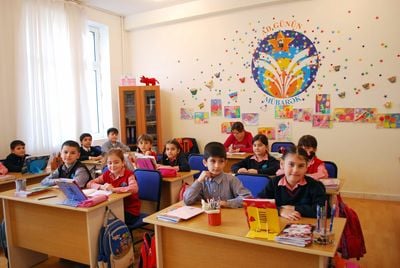Teaching Monolingual vs. Multilingual Groups: What You Need To Know

A multilingual class is a class where the learners speak a variety of first languages. A monolingual class is a class where all the learners speak the same first language. I have been working in international school setting for over 13 years. The classes are multilingual classes where students come from different cultures and English is the common language for them to communicate with their teachers and classmates.
Table of Contents
Are you ready to take a TEFL course?
By contrast, English classes in local schools and universities in China are considered to be monolingual classes since the students use their first language, Chinese, to communicate. The teacher has to remind them to not use their mother tongue constantly during class time. Whether monolingual and multilingual, they both have their advantages and disadvantages. Here I will use my working and study experiences to describe the pros and cons of both monolingual and multilingual classes.
This post was written by our TEFL certification graduate Vickie C.
Common Difficulties
In a monolingual class, students have common difficulties. With the same first language system, their grammar problems and pronunciation difficulties would be similar. For example, Chinese local students normally have problems with pronunciation. Some of them are considered as "lazy tongues" because in their mother tongue, Chinese, there was no alphabet system until the late 70s. They use pinyin to adapt to the alphabet system. Chinese students struggle in certain sounds and graphemes of the English phonic system. Chinese language does not have verb tenses, verb phrases, plural nouns, and subject verb agreement and much more. A teacher can use this knowledge to deal with all the common difficulties in a whole group.
While in a multilingual class, students have no common language difficulties. The range of difficulties can vary from pronunciation to verb tenses; and from sentence structure to vocabulary. When working in a multilingual class, teachers find it hard to clarify difficulties in a whole group. They have to locate the difficulties for individual students and come up with the strategies what work specifically for each of them. This is something I also have found challenging in an International School setting. For example, we have Dutch, Korean, Japanese and Spanish students. Their language difficulties are very different. To help them, we have the ELL support teacher who work closely with beginners and low-intermediate students to meet their specific needs. We also have reading support to teach them phonemic awareness and reading strategies. However, it is still quite a challenge to teach beginners who don't share any common language with us. In essence, it would be helpful that the teacher has certain knowledge of some language background so that they would have a better understanding of students' language difficulties.
Also read: What it's Like to Teach English Online: An Online Teacher Reveals Her Secrets!

Common Culture
Students from a monolingual class usually share the same culture. There wouldn't be any culture shock within the group. A teacher would only face students from one culture that he or she can teach them as a whole group for many subjects or topics. They wouldn't need to consider a lot of ethical issues to carry out their teaching activities.
While in a multilingual class, students have different cultures within the group. They will soon find out there are different cultures in the classroom. This provides a natural information gap. Their experiences and schemata from their own culture can be used to enrich the whole group's language learning. For example, when teaching the topic celebration, students can bring in a large variety of experiences that are related to it. Chinese students can talk about how they celebrate Chinese New Year and Western students can talk about how they celebrate New Year. This activity could make the learning experience more fun and engaging for the students as they would be learning from one another.
A teacher who teaches a multilingual class might have to face several different cultures which could be a disadvantage. In my school, there might be five or six different cultures that exist in a class. As teachers, we need to have cultural awareness and certain knowledge of political issues not to offend any cultural groups.
Also read: 4 Top Tips For Getting Your TEFL Certificate on the Road

Exposure to English
I was once a student in a Chinese University English class. Most of the time, our teacher had to constantly remind us to try and use English to express our thoughts. However, due to boredom, lack of English efficiency and other reasons, most of my classmates used Chinese to talk to the teacher during class. Our teacher was a native English speaker but fluent in Chinese. My classmates seemed to have fun hearing him speaking Mandarin. This is a disadvantage for monolingual classes since students would have less exposure to English. In such cases, some middle schools provide after school English programs. In some universities and high schools, student volunteer to organize an English Corner. English Corners are where English learners can meet once or twice a week to gain more English exposure through discussions, films and much more.
As an ELL teacher, we should consider a way of making our instruction clear and understandable for all students. We can use rules to make sure everyone speaks English during class discussions. In order to encourage students, we should avoid too much correction when they speak and show an understanding even when they make grammatical or pronunciation mistakes.
While in a multilingual class, the students have more exposure to English. My school is an IB International School and we use English to teach all subjects. Students are emerged in an English environment the entire school day. They are expected to use English to communicate. In the class, we set essential agreements (classroom rules) that students have to speak English to include everyone in the discussion so that no one is left out.
The downside is that the teacher may not understand the student's native language. It would be challenging for the students who are beginners to communicate with the teacher. According to the course, we should keep in mind to provide positive encouragement to the learners and frequently praise them since it is important for their language-growth process. We can use visual aids, simple language games, ask easy questions and modify teaching content to fit their language levels.
Also read: 10 Tips for Teaching Grammar to EFL Students Abroad

Mother Tongue
In a monolingual class, students are allowed to use their mother tongue to help each other comprehend abstract content. The same goes for a multilingual class. If an advanced student who happens to know other students' languages, he or she can use it to help their peers. In my school, we support our children's mother tongue to learn. When students use their mother tongue to process their thinking, learning is more likely to happen.
Are you ready to take a TEFL course?
Apply now & get certified to teach english abroad!
Speak with an ITTT advisor today to put together your personal plan for teaching English abroad.
Send us an email or call us toll-free at 1-800-490-0531 to speak with an ITTT advisor today.
Related Articles:
- TEFL Breakdown - What Subjects Will Your TEFL Course Cover?
- 5 Reasons Why Teaching English Abroad Enhances Your Career Prospects
- Top 5 Tips: How to Learn a New Language When Teaching English Abroad
- 4 Top Tips for Getting Your TEFL Certificate on the Road
- The How-To Guide for Americans to Teach English in Europe
- 5 Great Places to Teach English Abroad Without a Degree



